If you’re reading this, it means you’re on the lookout for the best smartwatch you can buy. Maybe your trusty Apple Watch has finally reached the end of its life, or perhaps your Android Wear OS timepiece met an unfortunate end after a not-so-graceful tumble off the table (thanks to your mischievous cat, no doubt).
Whatever the reason, smartwatches have come a long way. Whether you’re a fitness fanatic tracking every step, a busy professional managing notifications on the go, or simply someone who loves tech-packed accessories, there’s a perfect smartwatch for you. But with so many models offering different features, it can feel like a lot to sift through. That’s why we’ve curated this guide.
We’ve gathered the top smartwatches on the market right now to help you make your decision easier, whether you’re an iOS or Android user looking for an upgrade or a first-time buyer.
Why you can trust Stuff: Our team of experts rigorously test each product and provide honest, unbiased reviews to help you make informed decisions. For more details, read how we test and rate products.
Quick list: what’s the best smartwatch?
The best smartwatches you can buy today:
1. Apple Watch SE 2
| Apple Watch SE (2022) specs | |
|---|---|
| Processor | S8 SiP with 64‑bit dual-core processor |
| Display | Retina display, 368 x 448 pixels (44mm), 324 x 394 pixels (40mm) |
| Storage | 32GB |
| Connectivity | 4G LTE (cellular models), Bluetooth 5.0 |
| Rating | 50m waterproof (WR50) |
| Dimensions | 44 x 38 x 10.7mm / 33g (44mm), 40 x 34 x 10.7mm / 28g (40mm) |
The Apple Watch SE (aka the Apple Watch SE 2 or 2022 model) might not be the most premium Apple Watch available, but it’s still our top recommendation for most people. Cheaper than its Apple Watch Series 8 and Watch Ultra siblings, it manages to serve up some of the same key features, for less.
These include the same processor, Apple’s vast menu of health and fitness features, and even newer features like Car Crash Detection. Compromises for the price include the lack of an always-on display, bloody oxygen tracking, and ECG smarts. But if you’re not fussed about those and want an up-to-date Apple Watch for a more palatable price, this is the one for you.
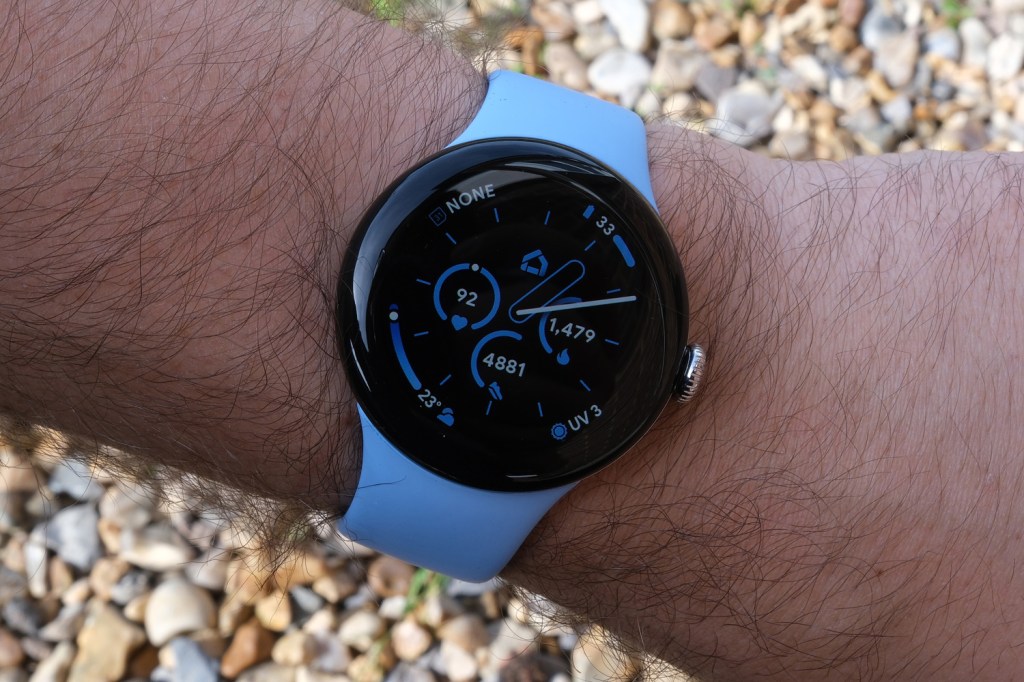
2. Google Pixel Watch 2
| Google Pixel Watch 2 specs | |
|---|---|
| Processor | Qualcomm Snapdragon Wear W5 |
| Display | 1.2in, 450×450 AMOLED |
| Storage | 32GB |
| Connectivity | Bluetooth 5.0, NFC, Wi-Fi |
| Rating | 5ATM |
| Dimensions | 41x41x12.3mm, 31g (watch body only) |
Google’s Pixel Watch 2 should be a top contender for Android purists who crave a device directly from the Big G itself. With its standout minimalist styling and easy-to-use interface, the Pixel Watch 2 is a pleasure to wear and use. Slick software and comprehensive Fitbit-powered health tracking are welcome features too.
The second generation has received a larger battery and more efficient processor, fixing one of our biggest issues with the first-generation model.
It’s still not perfect, however, the slightly thick bezels might detract from its visual appeal somewhat and the one-size-fits-all approach doesn’t fit all wrists, but if you’re after an Android-friendly timepiece with a fuss-free design, this is definitely one of the best smartwatches you can buy.
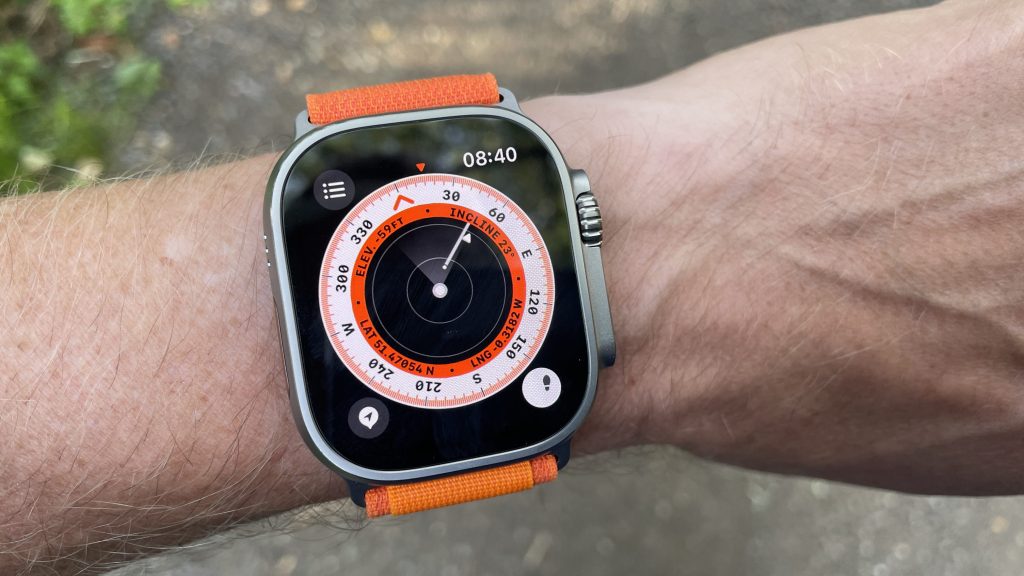
3. Apple Watch Ultra 2
| Apple Watch Ultra specs | |
|---|---|
| Processor | S8 SiP with 64‑bit dual-core processor |
| Display | Always-on 2000nit retina display, 410 x 502 pixels |
| Storage | 32GB |
| Connectivity | 4G LTE (cellular models), 802.b/g/n Wi-Fi, Bluetooth 5.3, dual-frequency GPS |
| Rating | 100m waterproof (WR100) |
| Dimensions | 49 x 44 x 14.4mm, 61g |
Apple fans with premium budgets take note — the Apple Watch Ultra is easily one of the best smartwatches in 2023, and you’d hope so, given that it’s also one of the most expensive options by a considerable mile.
Your extra cash nets you a bigger battery, more controls, a beefed-up rugged design, and specialist features tailored to outdoor pursuits. It’s more than a tentative step into Garmin territory, though its battery life will still force you back on charge faster than top-end Garmin models.
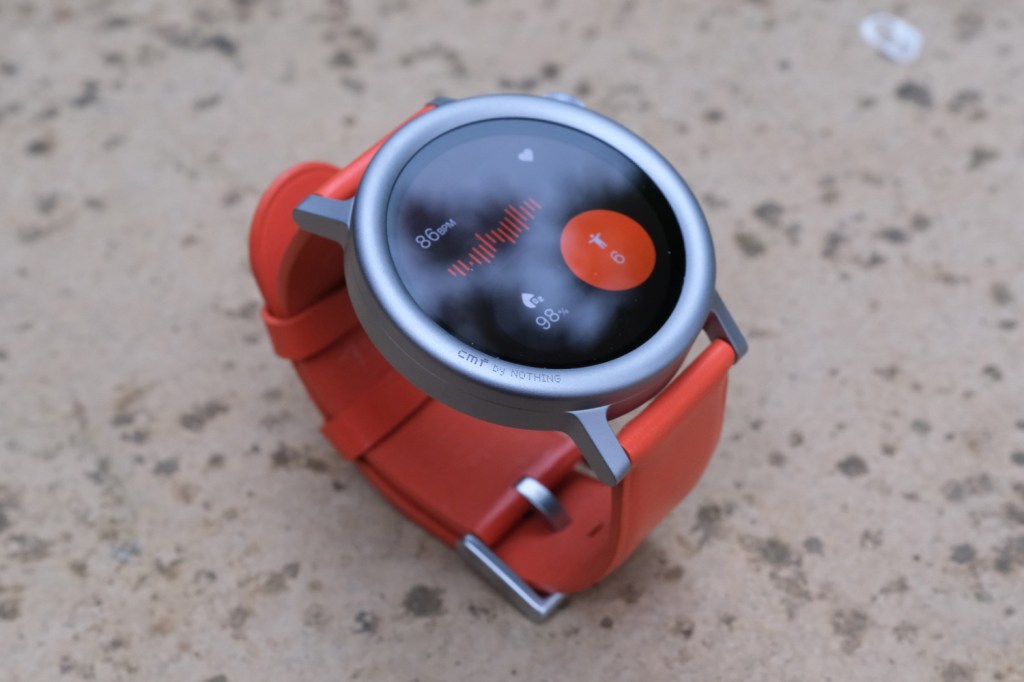
4. CMF Watch Pro 2
| CMF Watch Pro 2 specs | |
|---|---|
| Processor | Not stated |
| Display | 1.32in 466×466 circular AMOLED |
| Storage | Not user-accessible |
| Connectivity | GPS, Bluetooth |
| Rating | IP68 |
| Dimensions | 57x51x19mm, 48g |
The CMF Watch Pro 2 refines the budget smartwatch concept, offering an affordable option that doesn’t skimp on style or performance. Priced at just US$69/£69, it impresses with its streamlined circular design, customisable bezels, and user-friendly interface. We appreciate that it covers all the essential smartwatch features, like notifications, fitness tracking, and GPS, while lasting up to a week on a single charge—outperforming many pricier competitors. The AMOLED display is bright, sharp, and easy to read, with automatic brightness finally making an appearance.
However, it’s not all smooth sailing. The absence of an app store and contactless payments is a noticeable downside, especially as even cheaper wearables offer these features. Additionally, while the watch can handle light splashes, swimmers will need to look elsewhere due to limited water resistance. That said, for general fitness fans and those new to smartwatches, the CMF Watch Pro 2 delivers a solid experience. It won’t rival premium smartwatches like the Apple Watch or Samsung Galaxy series, but at this price, it’s not trying to. It’s all about nailing the basics, and it does just that—beautifully.
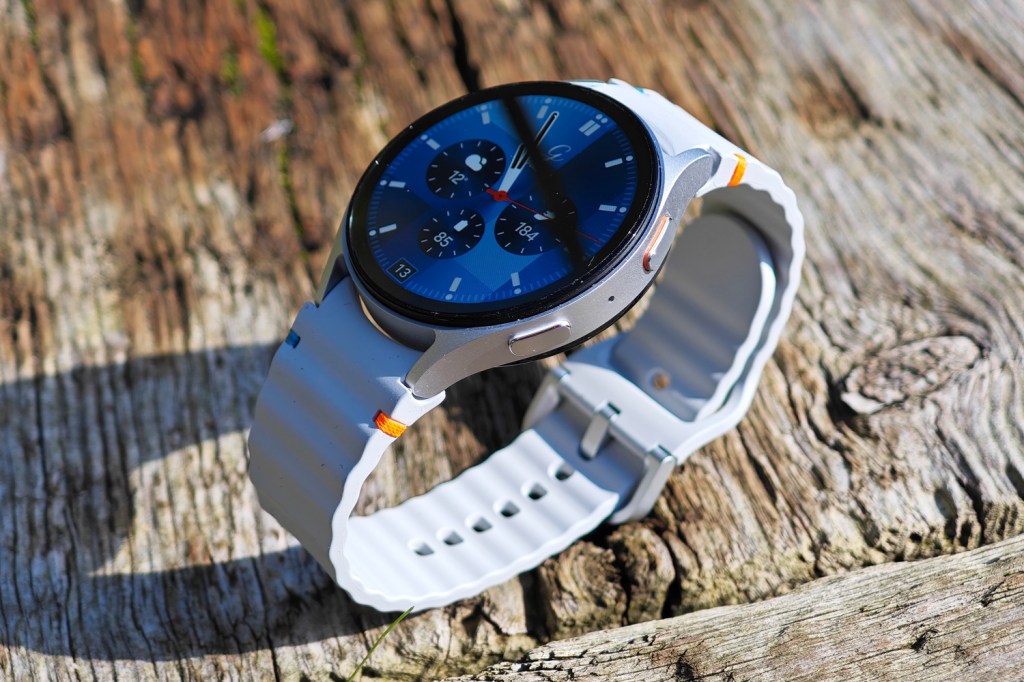
5. Samsung Galaxy Watch 7
| Samsung Galaxy Watch 7 specs | |
|---|---|
| Processor | Samsung Exynos W1000 |
| Display | 1.3in 432×432 AMOLED (40mm) / 1.5in 480×480 AMOLED (44mm) |
| Storage | 32GB |
| Connectivity | Bluetooth 5.3, Wi-Fi, NFC, GPS (4 bands), LTE |
| Rating | IP68, 5ATM |
| Dimensions | 41x41x9.7mm, 28.8g (40mm) / 45x45x9.7mm, 33.8g (44mm) |
The Samsung Galaxy Watch7 is a continuation of the brand’s WearOS dominance, maintaining its lead with a faster Exynos W1000 chipset, more efficient performance, and double the onboard storage at 32GB. Though the design hasn’t dramatically changed, the tweaks, such as new strap colours and subtle details, are appreciated. We also welcome the inclusion of dual-frequency GPS, positioning it closer to dedicated sports watches in terms of accuracy.
The AMOLED display remains bright and sharp, and the 44mm model is our pick for its better battery life and overall fit. However, the watch still needs recharging every two days—something that hasn’t improved much from the previous generation, despite the more efficient CPU.
Samsung has stepped up with health and fitness tracking, offering more accurate readings thanks to upgraded bio-sensors. The watch also introduces a new Energy Score, though it feels more basic compared to Garmin’s Body Battery.
Atsunder US$300/£300 for the base model, the Galaxy Watch7 offers great value and stays ahead of the competition like the Google Pixel Watch 3 and Apple Watch Series 9. For Android users, it’s simply the best all-rounder smartwatch, even if battery life remains a minor sticking point.

6. Samsung Galaxy Watch Ultra
| Samsung Galaxy Watch Ultra specs | |
|---|---|
| Processor | Samsung Exynos W1000 |
| Display | 1.5in, 480×480 AMOLED |
| Storage | 32GB |
| Connectivity | Bluetooth 5.3, Wi-Fi, NFC, GPS (4 bands), LTE |
| Rating | IP68, 5ATM |
| Dimensions | 48x48x12.1mm, 60.5g |
The Samsung Galaxy Watch Ultra is a rugged smartwatch designed for adventurers and athletes, seamlessly blending WearOS smarts with extreme sports capability. Its 47mm titanium case makes it tough and weather-resistant, although it’s bulkier than previous Galaxy Watches. We love its bold design, complete with a sharp AMOLED screen, bright 3000 nits display, and durability for outdoor use. However, it only offers a two-day battery life, which feels a bit short, especially compared to Garmin’s sport watches.
While the watch excels in fitness tracking, offering accurate heart rate monitoring, dual-frequency GPS, and a multi-sports mode for triathletes, it lags in handling watersports—Apple’s Watch Ultra has the edge there. Its design, square case but circular screen, is eye-catching, although we aren’t thrilled about Samsung’s proprietary lugs limiting band options.
With WearOS 5, performance is smooth and responsive, and although it shares many features with the Galaxy Watch7, the Ultra justifies its price with a more rugged, premium feel. For Android users looking for a robust, statement-making watch, this is a strong contender, even if it falls short in battery life and watersport compatibility. Overall, it’s a powerhouse that competes confidently with Garmin and Apple, but with its own flair.
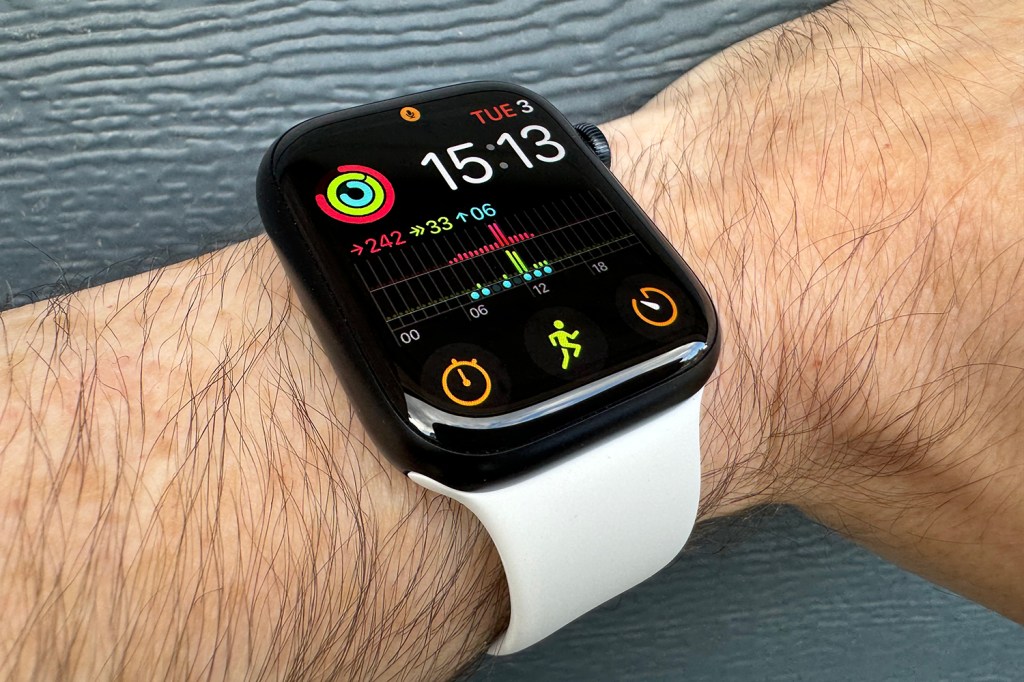
7. Apple Watch Series 9
| Apple Watch Series 9 specs | |
|---|---|
| Processor | S9 SiP with 64‑bit dual-core processor |
| Display | Retina display, 396×484 pixels (45mm), 352×430 pixels (41mm) |
| Storage | 64GB |
| Connectivity | Bluetooth, Wi-Fi, NFC, GPS (4 bands), LTE |
| Rating | 50m waterproof (WR50), IP6X (dustproof) |
| Dimensions | 45x38x10.7mm, 38.7–51.5g (45mm), 41x34x10.7mm, 32.1–42.3g (41mm) |
The Apple Watch Series 9 is a solid smartwatch, but it’s more of an incremental update rather than a game-changer. With a brighter display, more powerful S9 chip, and the exciting potential of the new double-tap feature, it offers an improved experience for first-time buyers. However, for those with a Series 8 or even Series 7, the lack of significant new features means there’s little reason to upgrade.
Pros include the brighter 2000-nit display and the more powerful SiP (System in Package), which ensures better performance. Apple’s commitment to sustainability with its carbon-neutral options is commendable, though we think truly being green means offering devices that last longer than a few years.
On the downside, battery life remains unchanged, and the much-touted double-tap feature isn’t available at launch. The design hasn’t evolved much either, still requiring an iPhone for full functionality.
If you already own a Series 8 or earlier, there’s no big rush to upgrade unless you’re keen on the incremental improvements. It’s a great device, just not a revolutionary one.
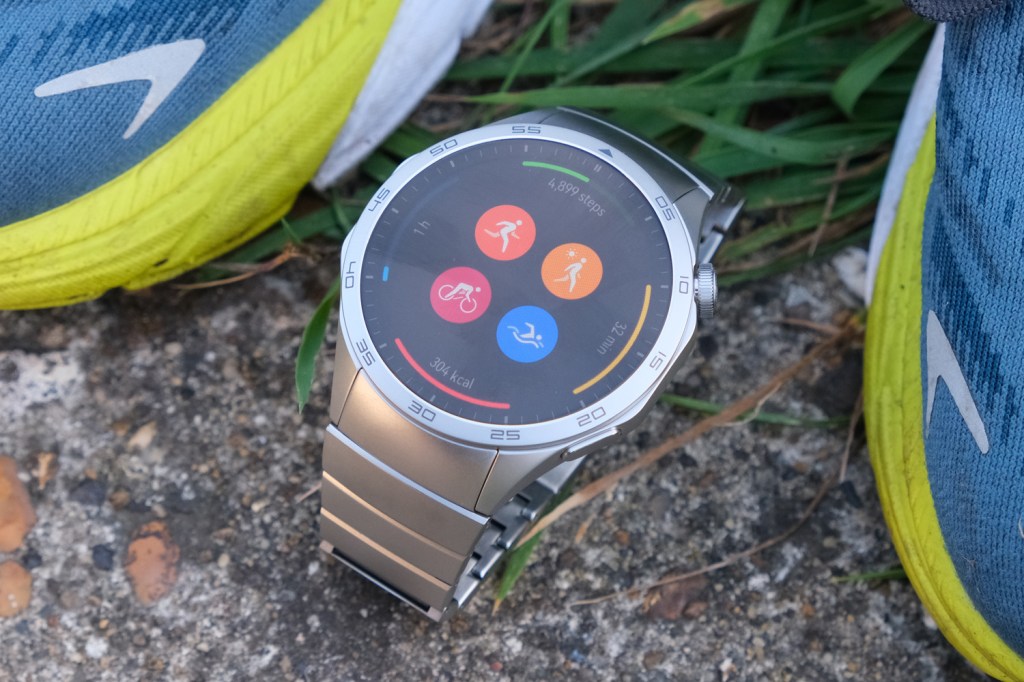
8. Huawei Watch GT 4
| Huawei Watch GT 4 specs | |
|---|---|
| Processor | Undisclosed |
| Display | 1.43in, 466×466 OLED |
| Storage | Undisclosed |
| Connectivity | GPS, Bluetooth, NFC (country-dependent) |
| Rating | 5ATM, IP68 |
| Dimensions | 46x46x10.9mm, 48g (excluding strap) |
If design and materials quality matter most when it comes to your wristwear, it’s hard to dislike the Huawei Watch GT 4. It’s a fantastic-looking smartwatch that makes similarly-priced rivals look positively toy-like in comparison. Battery life remains superb and the screen is a stunner.
Our usual software hang-ups, unfortunately, remain: installing the companion app is fiddly, third-party software support is super-limited, and most buyers will miss out on features found in competing watches like voice assistants and contactless payments. And as much as we think it’s better looking than any Apple Watch, it’s not going to convince any iPhone owners to make the switch.
Treat it as a fitness watch with a bunch of bonus smart features, though, and the Watch GT 4 makes a lot more sense. Huawei Health is detailed enough for both casual exercise and serious workouts, and does daily health tracking very well indeed. For many that – and the sublime styling – will be enough to overlook its issues.
How to choose the best smartwatch for you
If you’re struggling to choose the right smartwatch then fear not – Stuff’s wearable experts are here to help you make the right decision. Luckily, if you own an iPhone, choosing the perfect smartwatch is easy – you should buy an Apple Watch.
Which Apple Watch you buy comes largely down to taste and budget, but there’s no denying the Apple Watch fits perfectly in the iOS ecosystem.
Of course, Apple Watches aren’t compatible with Android phones, so if you own a Google-powered phone then you’ll need to look elsewhere. Thankfully, there are plenty of Android-compatible smartwatches out there to choose from.
In terms of the operating system, you’ve got several options, but the natural fit for an Android phone is a smartwatch that runs Google’s Wear OS. There are a number of different manufacturers that use Wear OS, from Samsung and Fossil to TAG Heuer and Montblanc. So you can buy a watch that suits your personal style. For more information on this, check out Stuff’s guide to the best Android smartwatches.
If you’re not a fan of Wear OS, then you could opt for a smartwatch from Garmin, Huawei, or Fitbit, all of which run bespoke operating systems. Want a sports watch instead? Check out our guide to the best GPS watch.
When choosing a smartwatch, specifications aren’t as important as they are when buying a phone or laptop. Smartwatch apps are all relatively lightweight, so even the most underpowered smartwatches rarely suffer from lag.
The specifications that do matter are display resolution and brightness, as you’ll want a clear screen that can be read in bright sunlight.
When it comes to battery, there are some smartwatches that offer battery life measured in days and weeks, but realistically you’re going to be charging most smartwatches every night. This isn’t too much of an issue, as it’s easy to get into a charging routine when charging frequently – just like charging your phone.
If battery life is a priority of yours, you could consider one of the best fitness trackers, which boast fewer features but have a much longer battery life.
Every smartwatch connects to your phone with Bluetooth, but some also have a 4G data connection. This allows you to make calls, receive messages, and stream music on your watch even when your phone isn’t nearby. This feature does come with an extra monthly cost of the data, so you need to ask yourself if it’s really necessary.
Of course, there’s also wearability to consider – you want a smartwatch that looks good and is comfortable to wear, so weight and size are important factors to think about.
Finally, if you’re buying a smartwatch for your child, read Stuff’s guide to the best smartwatch for kids.
Apple Watch vs Android WearOS: which is the better smartwatch platform?
Need help deciding which smartwatch platform to go for? The answer is pretty simple. If you have an iPhone you’ll prefer the Apple Watch for its seamless integration with the Apple ecosystem, while Android users have to opt for WearOS (as the Apple Watch doesn’t work with Android phones).
When paired with the iPhone, the Apple Watch offers a highly polished user experience, superior build quality, and a wide range of health and fitness features. Regular software updates and extensive third-party app support further enhance its appeal.
On the other hand, WearOS, Google’s smartwatch platform, provides more flexibility and variety, catering to a broader range of devices from multiple manufacturers like Samsung and TAG Heuer. This diversity allows users to choose from various styles and price points. WearOS integrates well with Android devices, offering features like Google Assistant and Google Pay, and supports both Android and iOS.


